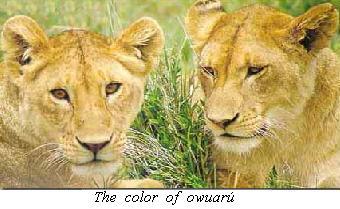Maa has an extremely rich set of about 30 color, and about 20 color-plus-design terms. Five of the color terms are Stative Verbs. The others are Adjectives. Some of the adjectival color terms clearly have developed from words that primarily designate objects, but for others there is no known synchronic noun (or verb) that they are related to. Some color terms are not known throughout the entire Maa-speaking area, while others are very wide-spread.
Table 1 contains color and design terms which, as far as we know, do not come from other more-basic Maasai words which name objects or actions.
 |
Table 2 contains color and design terms which
are derived from other Maa words whose primary meaning refers to an object
or action. The color and design senses develop as the object/action
words are used to refer to characteristics or resultant states typical
of the object/action. This is a very common process in all languages.
In English, for example, the word peach is most basically the name of a type of fruit (i.e., the name of an object). But peach can also name the color of a dress or the ink in a pen which is similar to the typical color of this fruit. It is the same process that accounts for the root in olowuarú 'carniverous beast' also being used to mean 'light red-brown color with camouflaging effect'. |
| STATIVE VERB | SOURCE of VERB (ALL ARE ACTIVE VERBS) | ADJECTIVE | GLOSS | SOURCE of ADJECTIVE (ALL ARE NOUNS) | GLOSS | |
| sagáràràmì | 'light-blue, purple' | o-sagáràràmì | 'acacia fruit/pods' | |||
| kúkúó | 'dark black, charcoal' | en-kúkúó | 'piece of charcoal' | |||
| d |
'gray' | n-d |
'vervet monkey' (Samburu dialect) | |||
| sérò | 'dull dark gray' | o-sérò | 'dry brush' | |||
| DERIVED | kútáí | 'cloud-white' | ?in-kútà | 'rain water' | ||
| COLOR | ókúrúóí | 'ash-white' | en-kúrúóí | 'hunk of ash' | ||
| TERMS | sírùà | 'cloud-white, nearing gray' | o-sírùà | 'eland' | ||
| sépérua | 'light brown' | e-sépérua | 'serval cat' | |||
| l |
'golden brown' | 'acacia tree' | ||||
| +sikítóì | 'yellow' | i-sikítòk | 'colustrum milk' | |||
| túlélèì | 'shiny yellow' | o-túlélèì | 'Sodom apple' | |||
| owuarú | 'light red-brown; gray; with camouflaging effect' | ol-owuarú | 'carniverous beast' | |||
| moríjoi | 'deep red, maroon' | ol-moríjoi | 'poison-arrow tree' | |||
| p |
'light red-based color' | ol-p |
'unripe pus' | |||
| súyaán | 'gray' | o-súyaní | 'wild dog, wolf' | |||
|
a-irimó |
a-irím |
kerî |
'spotted' |
ol-kerî |
'leopard' |
|
| 'conspicuously spotted with at least two colors' | 'to spot the body with chalk / ochre' | tárá | 'spotted & colorful' | en-tárâ | 'viper' | |
| DERIVED COLOR
+DESIGN TERMS |
márà | 'dotted, checkered,
involving at least red, black, or brown; spots the size of a cheetah's' |
ol-márà | 'cheetah' | ||
| túntáí | 'alternate black & white' | en-túntáí | 'oval black or white beads for necklace fringe' | |||
| a-s |
a-s |
y |
'black & white' | o-y |
'porcupine' | |
| 'striped, painted' | 'to mark' | 'brown with large dark-brown' | ol- |
'fig tree' | ||
| r |
'red top, white bottom' | o-r |
'termite' | |||
| leléo | 'with large circular patches' | o-leléo | 'broken gourd' |
Cognitively, some of the color terms are more "basic" than others, while
other terms are considered to be more finely-specified subtypes of the
basic terms (cf. Berlin and Kay 1969, 1975). Table 3 gives a grouping
done by Vincent Konchellah, who referrs to each of the terms in bold as
a "mother". Note that only the term for 'green' stands alone with
no sub-terms. The same task was done by a distinct group of four
Central Maa speakers working together. The Central Maa group placed
'to be blood red' as a sub-type of a-nyokíé . They also treated ![]() irô
and
múgíé as distinct from the 'black category', each having several
sub-terms. (For the most part they also did not include color-plus-design
terms in the sorting task.)
irô
and
múgíé as distinct from the 'black category', each having several
sub-terms. (For the most part they also did not include color-plus-design
terms in the sorting task.)
Table 3. SORT of MAA COLOR AND DESIGN TERMS (il-Wuaskinkishu Maa speaker)
| "MOTHER" TERMS | GLOSS OF "MOTHER" TERM | SUBORDINATE SUBTYPES |
| p |
'blue' | arûs 'spotted black and white'
sagáràràmì 'purple' kií 'blue' |
| sí k í t ô î | 'yellow' | síntêt 'pink, yellow; gray'
túlélèì 'yellow' |
| a - r Upon querrying, the speaker said he did not want to make any more “mothers” within this group.) |
'to be black' | kúkúó 'gray'
s múgíé 'warm brown' d pukótì 'black-white blend' keshúroi 'mixture' sérò 'brush gray' sámpù 'striped tan & white' tárá 'spotted' owuarú 'gray; reddish; camouflage' |
| a - d |
'to be blood-red' | p |
| a - n y o k í é | 'to be red' |
l barrikóì 'tan, light yellow-brown' r moríjoi 'deep-red, maroon' |
| a- |
'to be white' | ókúrúóí 'ash white'
sírùà 'could-white, nearing gray' (this could also occur under a-nyokíé) a-s |
| a - n y |
'to be green' | |
| k ú r r ú k ú r | 'mixture of colors' | wúâs 'patchy'
márà 'patchy' kerî 'spotted' (esp. black & white) leléo 'large circular spots' (esp brown) súyaán 'gray' |
Back to Maa Language